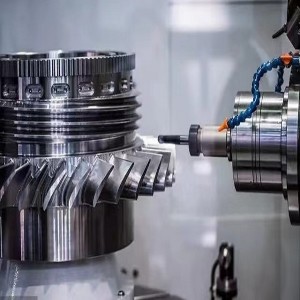First, the main processing object of CNC lathe.
CNC turning is one of the most used processing methods in CNC machining. Since CNC lathe has high processing accuracy, linear and circular interpolation function and automatic variable speed in the process, its processing range is much wider than that of ordinary lathe. Compared with ordinary lathe, CNC lathe is more suitable for turning rotary parts with the following requirements and characteristics:
1. Parts with high precision requirements
The precision requirements of the parts mainly refer to the precision requirements of size, shape, position and surface, where the surface precision mainly refers to the surface roughness. Because of the good rigidity of CNC lathe, high precision of manufacturing and tool setting, and the ability to easily and accurately carry out manual compensation and automatic compensation, it can process parts with high dimensional accuracy requirements, and some occasions can achieve the effect of turning instead of grinding. In addition, because the movement of CNC lathe is realized by high precision interpolation operation and servo drive, it can process parts with high requirements of shape accuracy such as straightness, roundness and cylindricity. Since the CNC lathe can finish processing more contents in one clamping, it can effectively improve the position accuracy of the parts and the processing quality is stable. CNC lathe has constant linear speed cutting function, so it can not only process parts with small and uniform surface roughness, but also suitable for turning parts with different surface roughness requirements in various parts. The machining accuracy of general CNC lathe can reach 0.001 mm, and the surface roughness Ra can reach 0.16μm (precision CNC lathe can reach 0.02μm).
2. Parts with small surface roughness value
CNC lathe has the function of constant linear speed cutting, which can process the parts with small and uniform surface roughness value. The surface roughness depends on the feed and cutting speed under the condition that the material, finish turning allowance and tool have been determined. Cutting speed changes, resulting in inconsistent surface roughness after turning, using the constant line cutting function of CNC lathe, you can choose the best line speed to cut cone, sphere and end face, so that the surface roughness value after turning is small and consistent.
3. Parts with complex surface contour shapes
Since the CNC lathe has linear and circular arc interpolation function (some CNC lathes also have some non-circular arc curve interpolation function), it can turn rotary parts with complex shapes composed of any linear and various types of plane curves, including the list curves which cannot be described by equations after processing through fitting calculation. As shown in Figure 4-1, the forming surface of the closed inner cavity of the shell part cannot be processed on a normal lathe, but it can be easily processed on a CNC lathe.
4. Parts with special threads
CNC lathe has the function of processing all kinds of threads, including any straight, tapered and end threads with equal lead, increasing lead, decreasing lead and threads requiring smooth transition between equal and variable lead. Usually a pulse encoder is installed in the spindle box, and the spindle motion is transmitted to the pulse encoder 1:1 via a timing belt. When the spindle rotates, the pulse encoder sends a detection pulse signal to the CNC system to synchronize the rotation of the spindle motor with the cutting feed of the tool holder, which means that the tool holder moves the workpiece by one lead in the direction when the spindle rotates during thread machining. Moreover, the threads produced by turning have high precision and small surface roughness value.
With the rapid development of science and technology, society’s requirements for the structure, performance, accuracy, efficiency and variety of mechanical products are getting higher and higher, and the proportion of single-piece and small and medium-lot products is increasing. Traditional general-purpose, special machine tools and process equipment have not been well adapted to the high quality, high efficiency, diversified processing requirements.
CNC machine tools as a combination of electronic information technology and traditional machining technology, a combination of modern precision machinery, computers, communications, hydraulic pneumatic, optoelectronics and other multidisciplinary technology as a whole, effectively solving the complex, precise, small batch of variable parts processing problems, to meet the high quality, high efficiency and multi-species, small batch of flexible production requirements, to adapt to the needs of a variety of mechanical products rapidly update It represents the trend and trend of today’s machining technology.
Among them, because of its high efficiency, high precision and high flexibility, CNC lathes are increasingly widely used in the machinery manufacturing industry, becoming one of the most widely used CNC machine tools.
Post time: Feb-22-2023







